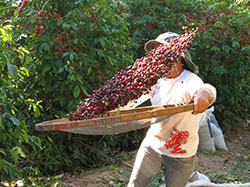- Home
- Resting Coffee After Roasting
Resting Coffee After Roasting
(This is a fairly long discussion, but if you are serious about home roasting, we guarantee it is worth your time to read to the end.)
By far, the most prevalent myth about coffee centers around it being a "fresh" product like lettuce or milk, insofar as minutes and hours count in terms of getting the freshest possible taste.
If we can't say this 1,000 times, then 1 time in bold type will have to suffice:
Roasted coffee is not a fresh vegetable or fruit. It doesn't belong in the refrigerator. It does not spoil or become stale in hours or even a few weeks if properly sealed. It does not have to be consumed within hours of roasting to get all the best flavors. You can relax and ignore the "Fresh" Freaks, they don't know what they are talking about and they thrive on one-upping each other in minimum lengths of time in which you must consume coffee before it becomes completely worthless.
In reality, coffee is an aged product. Like a filet mignon steak, wine, shortbread or even spaghetti sauce, coffee doesn't become coffee by being consumed and eaten immediately, it goes through a months-long process from picking to drying to hulling to storing to roasting and drinking. It is reduced to under 12% moisture content when green so that it will remain stable for months, even a couple of years.
The degree to which a coffee ages in a positive or negative way is affected by the coffee species and variety, how it is stored, and a number of other factors.
What happens when you roast coffee?
You are taking stable, stored green beans and subjecting them to a combustion process. You are roasting them. The applied heat is extreme, usually around 450°F. This causes a number of dramatic changes in the bean; the combustion process starts when roasted but does not really complete until long after roasting.
When you take the beans out of the roaster and cool them, they are not ready for consumption. Like a turkey from the oven that should sit and coalesce 15 minutes before being sliced, or a loaf of bread that needs to cool and outgas its yeast by-products, the optimal taste happens at some point AFTER taking it out of the heat.
If you slice a turkey straight from the oven, the juices will run and the meat will be drier. If you eat bread straight from the oven you will likely upset your stomach.
If you brew coffee straight from the roaster you will be consuming combustion elements that will make the coffee seem woody, bitter and flat.
Fresh-roasted coffee needs to "rest"!
Over the next few hours and even weeks, the coffee will ripen into its optimal taste profile and lose the negative combustion tastes. This is tricky to make general statements about. It is true that some coffees reach a delicious taste profile within minutes, but this is rare. Some reach an optimal taste within hours, but MOST coffees are best if rested at least 1 day, and many are best resting 3 days. Standard coffee shop procedure is to rest coffees between 1 and 3 days depending on the beans.
Dangerous and scary statements:
What we will say here defies the common myths you read every day about coffee. It is guaranteed to get you laughed at by people at cocktail parties who have never actually learned about this from experience, but simply believed and repeated the myths they have heard or read. But you will be right when saying it, and you can prove it by your own experience if you care to do so.
1. Coffee brewed from "New crop" beans is not necessarily better that brewed from "old crop" beans.
Explanation: Even though green beans are stable, they do continue to ripen inside as they are stored. If stored in cool temperatures at low humidity, they continue to develop certain compounds inside that affect flavor. After 1.5 - 2 years it is doubtful that they will improve; now they are actually beginning to lose quality. This is not true of all green beans, just most.
When the coffee is shipped at the end of the growing season, people assume it is at its best flavor profile. Yet again and again we have seen that this is not so. Sometimes the sugar content is so high people find the sweetness and fruitiness off-putting, and "not like coffee at all". Sometimes the new crop did not get as good weather as the previous crop, and the previous crop will be sought after first until it is gone. Sometimes the crops are equal in quality but have somewhat different flavor profiles, and you might prefer either the old or the new coffee.
To give a personal example, we once maintained some supply of Philippine Robusta for 3 years (we over-bought!). After the first 18 months we had trepidation about the condition of the beans (strictly because of the age) although they were stored optimally and looked great. Yet they roasted up wonderfully and as time went on, we got more enthusiastic comments after 2 years than we ever had before. At the very end, selling the last of the lot at almost 3 years, we had several customers tell us that it was hands-down the best Robusta they had ever tasted. Many people were upset to find out we were now out of inventory. Yet we have found other coffees lose quality after 18 months. We never know in advance the sweet spot of aging. That's part of the fun with coffee! And the reason to sample everything periodically.
2. The best taste is seldom right after roasting. Every coffee has a DIFFERENT need for rest after roasting.
We sometimes brew our Costa Rica Estate and Brazil Adrano right from the roaster, with maybe 20 minutes rest. It has a little bit of woodiness but its not enough to spoil that wonderful fresh-roasted taste.
We let most of other coffee rest at least several hours before we will even try to brew them. And we have a number of coffees we won't touch for 3 days, like anything that has been wet-hulled from Indonesia. If we brew it before then we just want to drain it down the sink, lol. Yet on Day 3 or 4 it becomes ambrosia.
3. Every coffee has a unique optimal taste profile period.
It is a total myth that all coffee starts to become stale and loses flavor after a few days. Some people begrudgingly extend this optimal fresh period to 18 days or so. But we find that few people actually study this, they just abide by a single rule.
We HAVE studied it, and we have found that (assuming all samples are properly sealed without any oxygen in the package) some coffees really do have an optimal taste profile of 3-18 days. However, most don't. We have several coffees at their peak between 5 days and 30 days. And we even have one very stubborn coffee, the Dalat Bourbon, that wants to be stored and forgotten for weeks or even 2-3 months. When opened even after 2-3 months, the Dalat Bourbon gets rave reviews when brewed. People who ignored it at 3 days or 10 days will beg to buy more.
People always want one rule that covers everything. No rules cover all coffees equally.
Conclusion:
We encourage you to do what we do, experiment. Try your coffee right after roasting, but seal some small packages for testing the next day and two more days after. You will probably be surprised to find out that not only is each coffee different, but you might in all cases prefer the well-rested coffees to the freshly roasted ones.
Disclaimers: We are aware that there are some methods used by commerical roasters that decrease the roasting time, or flash-cool the beans after roasting, or whatever. We also acknowledge that some of these methods eliminate much of the rest time needed for many coffees, and that some coffees can be enjoyed immediately after roasting with these methods. However, this article is devoted to discussion for home roasting, and these exceptions won't apply. Also, when used as espresso, the rest time may vary and in some cases not be needed. In other cases, though, creating espresso right after roasting will only concentrate the woodiness to an unbearable degree.
Latest Coffee Addition

Colombian Castillo Heritage Arabica!
Coffee from the days when Colombian coffee defined American consumer tastes. Warm, rich, delicious! Read more here!
 Loading... Please wait...
Loading... Please wait...


